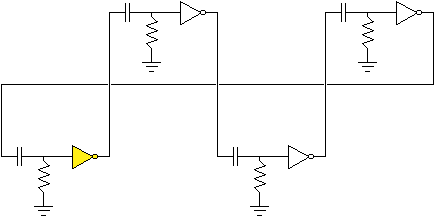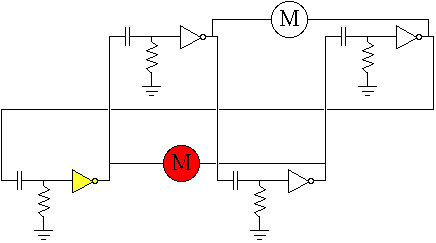|
|
BEAM From the Ground Up is a BEAM Reference Library site.
Quadcores
Nv nets with 4 neurons
The quadcore, or 4-Nv net, is by far the most-common variant of Nv net. You will sometimes also hear this circuit referred to as the "Microcore" -- although this term should strictly be used in reference to a "fully dressed" quadcore, complete with sensors and peripheral circuitry. In its "natural state," a quadcore will, at power-up, be saturated (with 2 processes active) -- here, the active inverter(s) are highlighted:

In most cases, though, this won't be what you desire -- you'll generally just want a single active process running:

Since 4 neurons will enable you to drive two motors in both directions, the most-common use for a quadcore circuit is as the motivating force behind a 2-motor walker. While I've got more information on this use elsewhere, here's an animation showing how this layout works (motor directions are arbitrarily shown by red or green):

|
In a 74HC14 microcore, the Schmitt input guarantees a single output transition when a Nv switches, which keeps it out of saturation. On the other hand, a microcore (or 6 Nv or 8 Nv core) made with "vanilla" 74*240 inverters will also "work" but will quickly saturate from noise picked up in the transition region. |
|
|
|
I've got descriptions of a number of quadcore
walker
circuits here. |
|
|
||
|
|
This page was last updated on |
|
